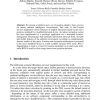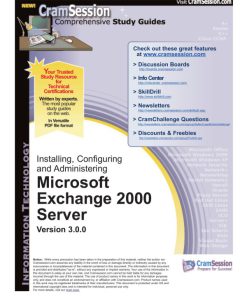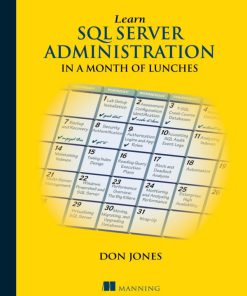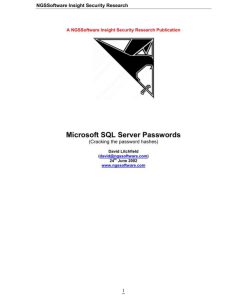Microsoft SQL Server 2005 1st edition by Michael Otey, Denielle Otey ISBN 0072260998 9780072260991
$50.00 Original price was: $50.00.$25.00Current price is: $25.00.
Authors:Fundamentos de Banco de Dados , Author sort:Dados, Fundamentos de Banco de , Languages:Languages:eng
Microsoft SQL Server 2005 1st edition by Michael Otey, Denielle Otey – Ebook PDF Instant Download/Delivery. 0072260998, 978-
Full download Microsoft SQL Server 2005 1st Edition after payment

Product details:
ISBN 10: 0072260998
ISBN 13: 978-0072260991
Author: Michael Otey, Denielle Otey
Microsoft SQL Server 2005 1st Table of contents:
Chapter 1: The Development Environment
- SQL Server Management Studio
- SQL Server Management Studio User Interface
- SQL Server Management Studio User Interface Windows
- SQL Server 2005 Administrative Tools
- BI Development Studio
- Business Intelligence Development Studio User Interface
- BI Development Studio User Interface Windows
- Summary
Chapter 2: Developing with T-SQL
- T-SQL Development Tools
- SQL Server Management Studio
- Visual Studio 2005
- Creating Database Objects Using T-SQL DDL
- Databases
- Tables
- Views
- Synonyms
- Stored Procedures
- Functions
- Triggers
- Security
- Storage for Searching
- Querying and Updating with T-SQL DML
- Select and Joins
- Modifying Data
- Error Handling
- Summary
Chapter 3: Developing CLR Database Objects
- Understanding CLR and SQL Server 2005 Database Engine
- CLR Architecture
- Enabling CLR Support
- CLR Database Object Components
- CLR Stored Procedures
- User-Defined Functions
- Triggers
- User-Defined Types
- Aggregates
- Debugging CLR Database Objects
- .NET Database Object Security
- Managing CLR Database Objects
- Summary
Chapter 4: SQL Server Service Broker
- SQL Server Service Broker Architecture
- Messages
- Queues
- Contracts
- Services
- Dialogs
- Developing SQL Service Broker Applications
- SQL Server Service Broker DDL and DML
- T-SQL DDL
- T-SQL DML
- Enabling SQL Server Broker
- Using Queues
- Sample SQL Server Service Broker Application
- SQL Server Service Broker Activation
- Dialog Security
- System Views
- Summary
Chapter 5: Developing with Notification Services
- Notification Services Overview
- Events
- Subscriptions
- Notifications
- Developing Notification Services Applications
- Defining the Application
- Compiling the Application
- Building the Notification Subscription Management Application
- Adding Custom Components
- Notification Services Application Sample
- Creating the ICF File
- Defining the ADF File
- Building the Notification Services Application
- Updating Notification Services Applications
- Building a .NET Subscription/Event Application
- Listing Subscriptions
- Adding Subscriptions
- Deleting Subscriptions
- Firing the Data Event Using .NET
- Firing the Data Event Using T-SQL
- Summary
Chapter 6: Developing Database Applications with ADO.NET
- The ADO.NET Architecture
- ADO.NET Namespaces
- .NET Data Providers
- Core Classes for the .NET Data Providers
- Core Classes in the ADO.NET System.Data Namespace
- DataSet, DataTable, DataColumn, DataRow, DataView, DataViewManager
- DataRelation, Constraint, ForeignKeyConstraint, UniqueConstraint, DataException
- Using the .NET Framework Data Provider for SQL Server
- Adding the System.Data.SqlClient Namespace
- Using the SqlConnection Object
- Connection String Keywords
- Opening a Trusted Connection
- Using Connection Pooling
- Using the SqlCommand Object
- Executing Dynamic SQL
- Executing Parameterized SQL
- Executing Stored Procedures with Return Values
- Executing Transactions
- Using the SqlDependency Object
- Using the SqlDataReader Object
- Retrieving a Fast Forward–Only Result Set
- Reading Schema-Only Information
- Asynchronous Support
- Multiple Active Result Sets (MARS)
- Retrieving BLOB Data
- Using the SqlDataAdapter Object
- Populating the DataSet
- Using the CommandBuilder Class
- Summary
Chapter 7: Developing with XML
- The XML Data Type
- Data Validation Using an XSD Schema
- XQuery Support
- Querying Element Data
- XML Data Type Methods: Exist(XQuery), Modify(XML DML), Query(XQuery), Value(XQuery, [node ref])
- XML Indexes
- Primary XML Indexes
- Secondary XML Indexes
- Using the For XML Clause
- For XML Raw
- For XML Auto
- For XML Explicit
- Type Mode
- FOR XML Path
- Nested FOR XML Queries
- Inline XSD Schema Generation
- OPENXML
- XML Bulk Load
- Native HTTP SOAP Access
- Creating SOAP Endpoints
- Using SOAP Endpoints
- Summary
Chapter 8: Developing Database Applications with ADO
- An Overview of OLE DB
- OLE DB Architecture Overview
- ADO (ActiveX Data Objects)
- OLE DB and ADO Files
- ADO Architecture
- An Overview of Using ADO
- Adding the ADO Reference to Visual Basic
- Using ADO Objects with Visual Basic
- Connecting to SQL Server
- Retrieving Data with the ADO Recordset
- Executing Dynamic SQL with the ADO Connection Object
- Modifying Data with ADO
- Executing Stored Procedures with Command Objects
- Error Handling
- Advanced Database Functions Using ADO
- Batch Updates
- Using Transactions
- Summary
Chapter 9: Reporting Services
- Reporting Services Architecture
- Reporting Services Components
- Installing Reporting Services
- Report Server
- Report Server Processors
- Report Server Extensions
- Report Manager
- Reporting Services Configuration and Management Tools
- Reporting Services Configuration Tool
- Report Server Command-Prompt Utilities
- Report Authoring Tools
- Report Designer
- Report Model Designer
- Report Builder
- Programmability
- Using URL Access in a Window Form
- Integrating Reporting Services Using SOAP
- Extensions
- RDL
- Accessing Reports
- Using URL Access
- URL Access Through a Form POST Method
- Report Authoring
- Development Stages
- Creating a Reporting Services Report
- Deploying a Reporting Services Report
- Running a Reporting Services Report
- Summary
Chapter 10: SQL Server Integration Services
- An Overview of SQL Server Integration Services
- Data Transformation Pipeline (DTP)
- Data Transformation Runtime (DTR)
- Creating Packages
- Using the SSIS Import and Export Wizard
- Using the SSIS Designer
- Using Breakpoints
- Using Checkpoints
- Using Transactions
- Package Security
- Deploying Packages
- Creating Configurations
- Using the Package Deployment Utility
- Programming with the SQL Server Integration Services APIs
- Summary
Chapter 11: Developing BI Applications with ADOMD.NET
- Analysis Services Overview
- XML for Analysis
- Analysis Management Objects (AMO) Overview
- ADOMD.NET Overview
- AMO Hierarchy
- ADOMD.NET Object Model
- Building a BI Application with ADOMD.NET
- Adding a Reference for ADOMD.NET
- Using the AdomdConnection Object
- Using the AdomdCommand Object
- Using the AdomdDataAdapter Object
- Using the CubeDef Object
- Summary
Chapter 12: Developing with SMO
- Using SMO
- Adding SMO Objects to Visual Studio
- Creating the Server Object
- Using SMO Properties
- SMO Property Collections
- SMO Hierarchy
- Building the SMO Sample Application
- Creating the Server Object
- Listing the Registered SQL Systems
- Connecting to the Selected SQL Server System
- Listing Databases
- Listing Tables
- Listing Columns
- Retrieving Column Attributes
- Creating Databases
- Transferring Tables
- Showing T-SQL Script for Tables
- SMO Error Handling
- Summary
Chapter 13: Using sqlcmd
- sqlcmd Components
- Command Shell
- Command-Line Parameters
- sqlcmd Extended Commands
- sqlcmd Variables
- Developing sqlcmd Scripts
- Developing sqlcmd Scripts with Query Editor
- Using sqlcmd Variables
- Using sqlcmd Script Nesting
- Using sqlcmd Variables and T-SQL Statements
People also search for Microsoft SQL Server 2005 1st:
microsoft sql server 2005 express edition download
microsoft sql server 2005 express with advanced services
what is microsoft sql server 2005 compact edition
sql server 2005 on windows 10
microsoft sql server express 2005 64 bit download
You may also like…
eBook CHM
Microsoft SQL Server 2000 Reporting Services Team LiB 1st Edition by Brian Larson ISBN 0072232161
eBook CHM
Inside Microsoft SQL Server 2000 3rd Edition by Kalen Delaney ISBN 0735609985 9780735609983
eBook PDF
Cracking MS SQL Server 2000 Passwords 1st Edition by NGSSoftware Insight Security Research












